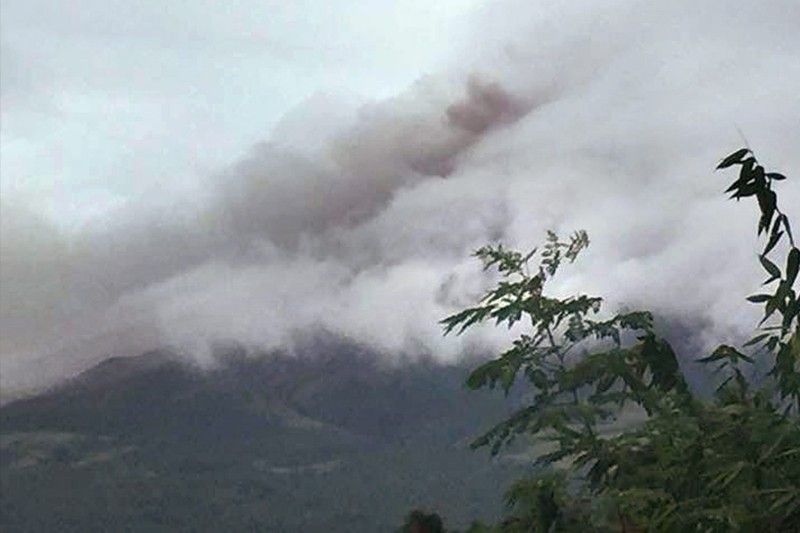4,000 flee as Mayon erupts anew

Mayon Volcano spewed ash three times in less than 24 hours. Photo courtesy of Albay Rep. Joey Salceda.
MANILA, Philippines — The Philippine Institute of Volcanology and Seismology (Phivolcs) raised the alert level of Mayon Volcano from 1 to 2 yesterday, following a steam-driven or phreatic eruption that caused ash fall events in some areas in Albay on Saturday.
Mayon had another phreatic explosion at 8:49 a.m. yesterday that lasted for about five minutes.
Phivolcs said the event produced a grayish steam and ash plume. Sulfurous odor and rambling sounds were also reported by residents of Barangay Anoling in Camalig town, it added.
At 12:30 a.m. yesterday, Phivolcs increased the alert status of Mayon from level 1 (abnormal) to 2 (increasing unrest), which means the origin of the unrest could be magmatic and lead “to more phreatic eruptions or eventually to hazardous magmatic eruptions.”
Local officials on Saturday ordered the evacuation of
residents of Camalig and Guinobatan towns in Albay who were affected by the ash fall.
In its latest bulletin issued at 8 a.m. yesterday, Phivolcs said a total of 78 rockfall events were recorded during the 24-hour observation period.
Saturday’s phreatic eruption, which lasted for approximately one hour and 47 minutes, generated grayish ash that covered the barangays of Anoling, Sua, Quirangay, Tumpa, Ilawod and Salugan in Camalig; and barangays Tandora, Maninila and Travesia in Guinobatan.
Sulfuric odor was also reported by residents of Camalig, while rumbling sounds were heard by residents of Barangay Anoling.
Mayon resident volcanologist Ed Laguerta said a volcano deflates normally after a phreatic explosion.
“We will be able to determine if the volcano is deflated after the phreatic explosion or it becomes inflated due to a new magma rising toward the crater in the coming days,” he said.
Laguerta said a team from Phivolcs main office will be arriving today to conduct further assessment on the sulfur gas output and the status of inflation.
Before the phreatic eruption, Laguerta said Mayon’s edifice had undergone inflationary changes or a slight swelling as indicated by ground deformation data recorded by continuous GPS and tilt since October and November 2017, respectively.
This indicates pressurization of the edifice by rising magma of Mayon’s subsurface hydrothermal system.
Laguerta said the team could probably use a drone to determine the status of the lava dome at the southeast portion of the volcano.
He said the status of the lava dome could not yet be determined and there’s greater risk for those living on the southeast portion of the volcano if the lava dome collapses.
The National Disaster Risk Reduction and Management Council (NDRRMC) is continuously monitoring the behavior of Mayon in coordination with Phivolcs.
The NDRRMC said traces of ash fall were found in the municipalities of Camalig, Guinobatan and Daraga in the province of Albay.
In coordination with its regional counterpart, the NDRRMC has also launched an information drive via text messaging through a prepared emergency alert and warning message.
The NDRRMC said the Provincial DRRMC of Albay has issued an evacuation order of residents within the six to eight-kilometer permanent danger zone of Mount Mayon.
Among the affected areas are the municipalities of Daraga with Barangays Miisi, Banadero and Matnog; Camalig with Barangays Anoling, Quirangay, Tumpa, Suha and Tinubran; and Guinobatan with Barangays Tandarora and Maninila.
Also ordered evacuated were residents of Ligao City with Barangays Baligang and Amti; Tabaco City with Barangays Magapo and Buang; and Malilipot with Barangays Canaway and Calbayog.
The Albay Public Safety and Emergency Management Office reported that at least 836 families or 3,378 people from Camalig and Guinobatan towns in Albay had already fled their homes and trooped to the evacuation centers.
The NDDRMC said assessments for possible response actions in case more eruptions take place are being conducted with the municipal disaster risk reduction teams even distributing facemasks for affected residents of the municipalities of Camalig, Guinobatan and Daraga.
NDRRMC executive director Ricardo Jalad said local government and civil defense officials in Bicol are on top of the situation.
“They have implementable evacuation plan which is not yet necessary as of now. We are appealing to the public to carry out safety precautions like observance of the six-kilometer radius and wearing of masks,” Jalad said.
Malacañang urged residents living near Mayon to heed the warnings of disaster management officials.
“We call on the people directly affected by the eruption of Mt. Mayon to cooperate with their respective LGUs (local government units) in order for us to avoid injuries or casualties,” Presidential Communications Secretary Martin Andanar said.
Phivolcs director Renato Solidum continued to urge people to cover their nose and mouth with damp, clean cloth or dust mask.
Solidum also reminded the public not to enter the six-kilometer radius permanent danger zone due to risk of sudden explosions, rockfall and landslides.
Solidum also called on civil aviation authorities to advise pilots to avoid flying close to the volcano’s summit as ash from sudden eruption can be hazardous to aircraft.
Solidum said based on the seasonal wind pattern, ash fall events may most likely occur on the southwest side of the volcano, which includes the towns of Daraga, Camalig and Guinobatan. – With Celso Amo, Cet Dematera, Alexis Romero
- Latest
- Trending































